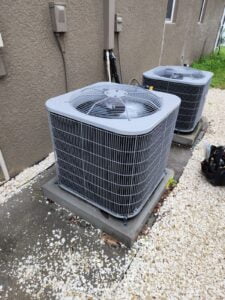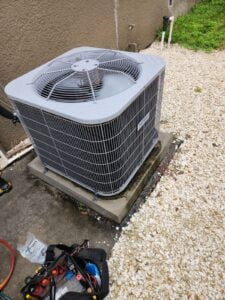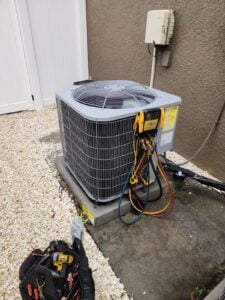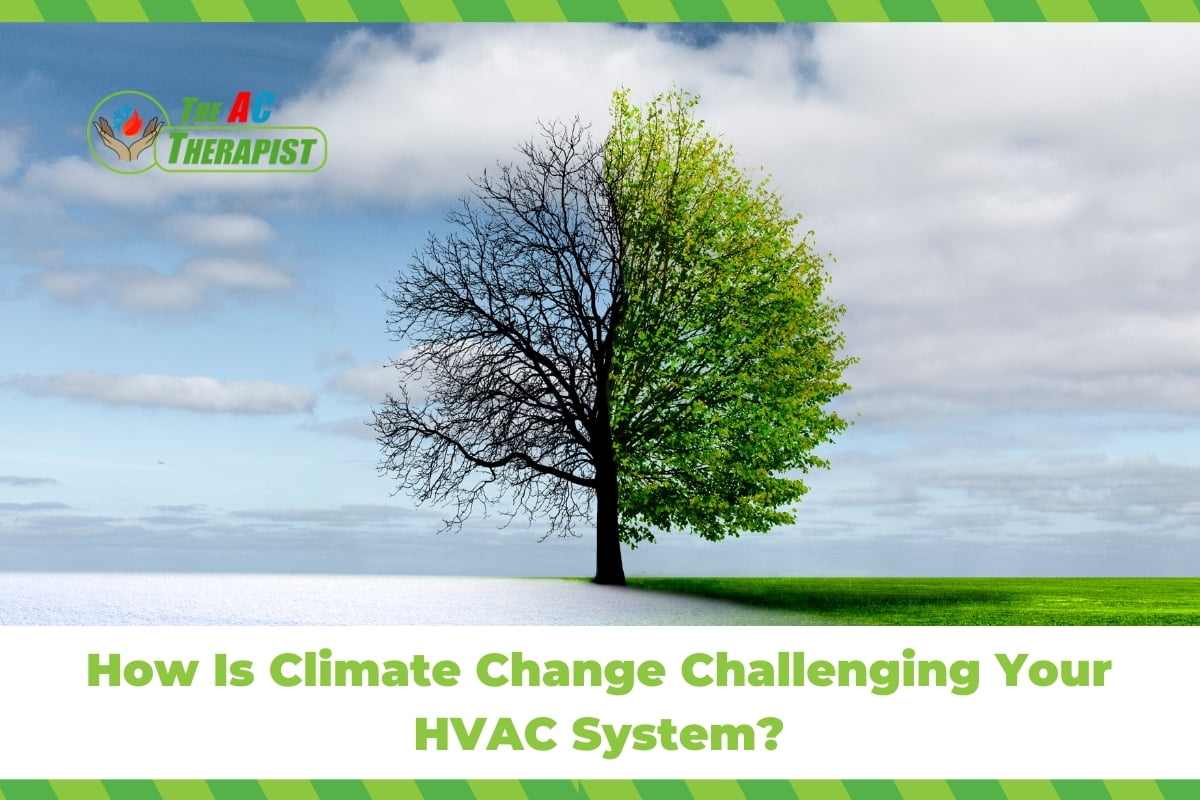How Is Climate Change Challenging Your HVAC System?
In recent years, the conversation around climate change has intensified, and its effects are becoming increasingly evident in our daily lives. One area where the impact of climate change is particularly noticeable is in the operation and efficiency of Heating, Ventilation, and Air Conditioning (HVAC) systems in homes and businesses. As temperatures rise and weather patterns shift, the demand for HVAC systems escalates, leading to a range of challenges. This blog delves into the various ways climate change is impacting HVAC systems and what it means for homeowners and businesses.
Understanding the Basics of Climate Change
Before we explore the impact on HVAC systems, it’s essential to understand what climate change entails. Climate change refers to significant, long-term changes in global climate patterns. Primarily driven by human activities, particularly the burning of fossil fuels, it leads to an increase in greenhouse gases in the Earth’s atmosphere. This increase causes the planet to warm, leading to various environmental changes, such as more frequent and severe weather events, rising sea levels, and shifting temperature patterns.
Increased Demand for HVAC Systems
One of the most significant impacts of climate change on HVAC systems is the increased demand for cooling. As global temperatures rise, particularly in warmer regions like Tampa Bay, the reliance on air conditioning systems intensifies. This increased demand is not just about comfort; in many cases, it’s about safety, especially during extreme heat events.
Higher Temperatures, Higher Usage
As average temperatures climb, air conditioning systems are required to operate for longer periods. This extended usage is necessary to maintain comfortable and safe indoor temperatures. However, this also means that HVAC systems are under constant stress, especially during peak summer months when temperatures can soar to particularly high levels.
Strain on System Capacity
Many existing HVAC systems, especially older models, were not designed to handle the prolonged and intense demands brought about by rising temperatures. This can lead to systems operating at or beyond their capacity, which not only reduces efficiency but also increases the risk of breakdowns. Homeowners may find that their current systems are no longer sufficient to cool their homes effectively, leading to uncomfortable living conditions and the need for system upgrades or replacements.
Impact on Energy Consumption
The increased demand for cooling directly translates to higher energy consumption. This not only has implications for household and business energy bills but also contributes to a larger environmental impact. As HVAC systems work harder and longer, they consume more electricity, much of which is still generated from fossil fuels, thereby contributing to greenhouse gas emissions. This creates a feedback loop where increased air conditioning use exacerbates the very problem of climate change that is causing the increased demand.
Need for Efficient Solutions
In response to this increased demand, there is a growing need for more efficient HVAC systems. Technologies such as inverter air conditioners, which can adjust their cooling output more precisely and efficiently, are becoming more popular. Additionally, smart thermostats and HVAC zoning can help manage energy use more effectively by providing better control over cooling in different areas of a building.
Preparing for Peak Demand
Homeowners and businesses need to prepare their HVAC systems for peak demand periods. Regular maintenance, such as those offered in the Therapy Maintenance Plans, can ensure that systems are running as efficiently as possible. Cleaning or replacing air filters, checking refrigerant levels, and ensuring that all components are in good working order can help prevent breakdowns during times of high usage.

Challenges in HVAC Efficiency
As the effects of climate change become more pronounced, HVAC systems face significant challenges in maintaining efficiency. Rising temperatures and fluctuating weather patterns not only increase the demand for heating and cooling but also affect the performance and efficiency of HVAC units. Understanding these challenges is crucial for homeowners, businesses, and HVAC professionals in areas like Tampa Bay, where climate change is altering the cooling and heating landscape.
Reduced Performance in Extreme Conditions
HVAC systems are generally designed to operate within certain temperature ranges. Extreme heat, which is becoming more common due to climate change, can push these systems beyond their optimal operating conditions. When air conditioners, for example, are forced to work in unusually high temperatures, their efficiency can drop significantly. This reduced efficiency means that the systems have to work harder and longer to achieve the desired indoor temperature, leading to increased wear and tear.
Increased Humidity Levels
Climate change is also associated with increased humidity levels in many regions. Higher humidity can have a substantial impact on HVAC efficiency, particularly for air conditioning systems. Air conditioners not only cool the air but also remove moisture. When humidity levels are high, these systems must expend more energy to dehumidify the air, which can further reduce their cooling efficiency and increase energy consumption.
Aging Infrastructure
Many existing HVAC systems, especially in older buildings, are not equipped to handle the new demands imposed by a changing climate. These older systems are often less efficient, to begin with, and may struggle to provide adequate cooling or heating as weather patterns shift. Upgrading to newer, more efficient systems can be costly, but it is often necessary to maintain comfort and manage energy costs effectively.
Increased Cooling Loads
As temperatures rise, the cooling load – the amount of cooling required to maintain a comfortable indoor environment – also increases. This is particularly true in residential and commercial buildings that lack adequate insulation or have design features that contribute to higher indoor temperatures (such as large windows or poor ventilation). The increased cooling load puts additional strain on HVAC systems, leading to reduced efficiency and higher energy costs.
The Challenge of Retrofitting
Upgrading or retrofitting existing HVAC systems to improve efficiency and cope with the demands of a changing climate is a significant challenge. Retrofitting can involve not only replacing the HVAC unit itself but also making changes to ductwork, insulation, and building controls. These upgrades require investment and can be disruptive, but they are often necessary to improve efficiency and reduce long-term operating costs.
The Importance of Regular Maintenance
Regular maintenance becomes even more critical as HVAC systems face increased strain. Maintenance tasks such as cleaning coils, replacing filters, and checking refrigerant levels can help ensure that systems operate as efficiently as possible. Regular check-ups can also identify potential issues before they lead to system failures, particularly during periods of peak demand.
Embracing New Technologies
To address these efficiency challenges, there is a growing emphasis on adopting new HVAC technologies. Innovations like variable refrigerant flow (VRF) systems, advanced heat pumps, and smart thermostats offer improved efficiency and better adaptability to changing environmental conditions. These technologies can provide more precise temperature control, reduce energy consumption, and lower greenhouse gas emissions.

The Need for Regular Maintenance
In the context of climate change and its impact on HVAC systems, the importance of regular maintenance cannot be overstated. As temperatures rise and weather patterns become more unpredictable, HVAC systems are subjected to increased stress and wear. Regular maintenance is essential to ensure these systems continue to operate efficiently and effectively, minimizing breakdowns and extending their lifespan. This is particularly relevant for residents and businesses in areas like Tampa Bay, where the climate can place significant demands on HVAC units.
Ensuring Optimal Performance
Regular maintenance helps keep HVAC systems running at their best. Tasks such as cleaning air filters, checking refrigerant levels, inspecting electrical connections, and cleaning coils are crucial for maintaining system efficiency. When these components are not regularly serviced, the system can work harder than necessary, leading to increased energy consumption and higher utility bills.
Preventing Breakdowns
One of the primary benefits of regular maintenance is the prevention of unexpected breakdowns. During maintenance visits, technicians can identify and address minor issues before they develop into major problems. This proactive approach is especially important during peak seasons when HVAC systems are under the most strain. A breakdown during a heatwave or cold snap can be more than just an inconvenience; it can be a serious health hazard.
Extending System Lifespan
HVAC systems are significant investments, and regular maintenance can extend their lifespan, ensuring that homeowners and businesses get the most out of their investments. By keeping the system in good working order, regular maintenance reduces the likelihood of premature system failure and the need for costly replacements.
Improving Energy Efficiency
Well-maintained HVAC systems operate more efficiently. When all components of the system are functioning correctly, it requires less energy to heat or cool a space, leading to lower energy consumption and reduced environmental impact. In the era of climate change, improving energy efficiency is not only beneficial for reducing utility bills but also for decreasing the carbon footprint of heating and cooling systems.
Enhancing Indoor Air Quality
Regular HVAC maintenance also plays a vital role in maintaining indoor air quality. Over time, dust, pollen, and other airborne contaminants can accumulate in the system and ductwork. Without regular cleaning, these contaminants can be circulated throughout the building, potentially leading to health issues for occupants. Regular maintenance ensures that air filters are clean and functioning properly, which is crucial for filtering out pollutants and allergens.
Adapting to Climate Change
As the climate continues to change, the demands placed on HVAC systems will likely increase. Regular maintenance becomes even more critical in this context, as it ensures that systems are prepared to handle these increased demands. Maintenance can also provide an opportunity to make adjustments or upgrades to the system, such as installing more efficient components, that can help it better cope with the effects of climate change.
The Role of Maintenance Plans
Maintenance plans, like the Therapy Maintenance Plans offered by The AC Therapist, provide a convenient and effective way to ensure regular HVAC maintenance. These plans often include scheduled inspections and servicing, priority service for repairs, and discounts on parts and labor. By enrolling in a maintenance plan, homeowners and businesses can have peace of mind knowing that their HVAC systems are being cared for by professionals.
Impact on Indoor Air Quality
The impact of climate change on HVAC systems extends beyond temperature control and energy efficiency; it also significantly affects indoor air quality (IAQ). As the climate changes, bringing about increased temperatures, humidity levels, and pollution, the challenge of maintaining healthy indoor air becomes more complex. For residents and businesses in areas like Tampa Bay, understanding and addressing these changes is crucial for ensuring a safe and comfortable indoor environment.
Increased Pollutants and Allergens
Climate change contributes to higher concentrations of outdoor air pollutants and allergens, such as pollen, dust, and mold spores. These contaminants can infiltrate indoor spaces, particularly if HVAC systems are not adequately maintained or if they lack proper filtration capabilities. The result can be a decline in indoor air quality, which can have adverse effects on health, particularly for individuals with allergies, asthma, or other respiratory conditions.
Higher Humidity and Mold Growth
Rising temperatures often lead to increased humidity levels, which can create an environment conducive to mold and mildew growth inside buildings. HVAC systems play a crucial role in regulating indoor humidity levels. However, if these systems are not functioning correctly or are not properly maintained, they may fail to effectively control humidity, leading to excess moisture and the potential for mold growth. This not only degrades air quality but can also cause structural damage to buildings and health problems for occupants.
Ventilation Challenges
As buildings become more energy-efficient and airtight to cope with the demands of a changing climate, the issue of ventilation becomes increasingly important. Proper ventilation is essential for ensuring a continuous supply of fresh air and for diluting and removing indoor pollutants. However, if HVAC systems are not designed or adjusted to account for these tighter building envelopes, indoor air quality can suffer due to inadequate ventilation.
The Role of HVAC in Air Filtration
HVAC systems equipped with high-quality air filters are vital for maintaining good indoor air quality. Filters with higher MERV (Minimum Efficiency Reporting Value) ratings are more effective at capturing small particles, including common allergens and pollutants. Regular replacement or cleaning of these filters is essential for ensuring they function effectively. Additionally, technologies like UV light installations can further enhance air quality by neutralizing airborne pathogens and contaminants.
Ductwork Maintenance
The condition of a building’s ductwork also plays a significant role in indoor air quality. Leaky or dirty ducts can distribute contaminants throughout a building and reduce the overall efficiency of the HVAC system. Regular duct cleaning, inspection, and maintenance are crucial for preventing the accumulation of dust, mold, and other pollutants in the ducts and ensuring the efficient distribution of clean air.
Monitoring and Improving IAQ
Monitoring indoor air quality is an essential step in managing its impact on health and comfort. Devices that measure indoor air pollutants, humidity levels, and temperature can help identify issues with indoor air quality. Once identified, steps can be taken to address these issues, such as adjusting the HVAC system, improving ventilation, or using air purifiers.
Educating Occupants
Educating building occupants about the importance of indoor air quality and how their activities can impact it is also crucial. Simple actions like avoiding the use of certain cleaning products, ensuring proper ventilation when cooking, and not smoking indoors can significantly improve indoor air quality.
The Role of Insulation and Building Design
In the face of climate change, the importance of insulation and building design cannot be overstated. As climate change continues to alter our environmental conditions, the way we design and insulate our buildings plays a crucial role in mitigating its impacts. Effective insulation and thoughtful building design are key strategies in adapting to the challenges posed by climate change, particularly in maintaining energy efficiency and comfort within our living and working spaces.
Insulation as a Defense Against Climate Change
Insulation is a critical component in the fight against the effects of climate change on buildings. Proper insulation helps to maintain a stable indoor environment, reducing the need for excessive heating or cooling as external temperatures fluctuate due to climate change. This is particularly important as climate change leads to more extreme weather conditions, including hotter summers and, in some regions, colder winters. By minimizing heat transfer, insulation helps to lessen the burden on HVAC systems, which is essential as these systems face increased demands due to climate change.
Building Design Adaptations for Climate Change
Building design must also evolve in response to climate change. Architects and builders are increasingly recognizing the need to design structures that can withstand the changing climate. This includes considering factors like orientation, window placement, and materials, which can all significantly impact a building’s energy efficiency. For instance, designing buildings with larger overhangs can provide shade and reduce cooling needs, a consideration that becomes more critical as climate change leads to higher temperatures.
Energy Efficiency in the Context of Climate Change
Energy efficiency is a major concern in the era of climate change, and both insulation and building design are at its forefront. Efficient buildings not only reduce greenhouse gas emissions but also lower energy costs for occupants. As climate change continues to drive up energy demands, particularly for cooling, the role of energy-efficient design and insulation becomes increasingly important. This includes the use of high-performance insulation materials and the incorporation of renewable energy sources into building designs.
The Impact of Climate Change on Building Materials
Climate change also influences the choice of building materials. Materials that are durable and can withstand the effects of climate change, such as extreme weather events and increased humidity, are becoming more desirable. Additionally, the carbon footprint of building materials is a growing consideration. Choosing materials with lower environmental impacts contributes to the broader efforts to combat climate change.
Windows and Doors in Climate Change Adaptation
The design and insulation of windows and doors are also critical in adapting to climate change. Double or triple-glazed windows, for instance, can significantly reduce heat transfer, helping to maintain comfortable indoor temperatures despite the external climate changes. Similarly, well-insulated and properly sealed doors can prevent air leaks, which are increasingly problematic as climate change leads to more extreme temperature differences between indoors and outdoors.
The Role of Green Building Practices
Green building practices are gaining traction as an effective response to climate change. These practices include not only the use of sustainable materials and energy-efficient designs but also the incorporation of natural elements into buildings, such as green roofs and living walls. These features can help regulate building temperatures, reduce urban heat islands, and improve air quality, all of which are important considerations as we grapple with climate change.

Facing the Heat: How Climate Change Is Challenging Your HVAC System
In conclusion, the challenges posed by climate change to HVAC systems are both significant and multifaceted. As we have explored in this blog, climate change is leading to increased temperatures, greater humidity, and more extreme weather patterns, all of which place additional strain on HVAC systems. These changes demand more efficient cooling and heating solutions, regular maintenance, and a proactive approach to system management.
For homeowners and businesses in the Tampa Bay area, understanding and adapting to these challenges is crucial for maintaining comfort, ensuring system longevity, and managing energy costs. The AC Therapist, with its comprehensive range of HVAC services, stands ready to assist in navigating these challenges. From regular maintenance to efficient system upgrades, The AC Therapist offers the expertise and solutions needed to ensure your HVAC system is prepared for the impacts of climate change. Remember, as our climate continues to evolve, so too must our approach to heating and cooling. Trust The AC Therapist to be your partner in adapting to these changes and keeping your indoor environment comfortable, no matter what the weather brings.








